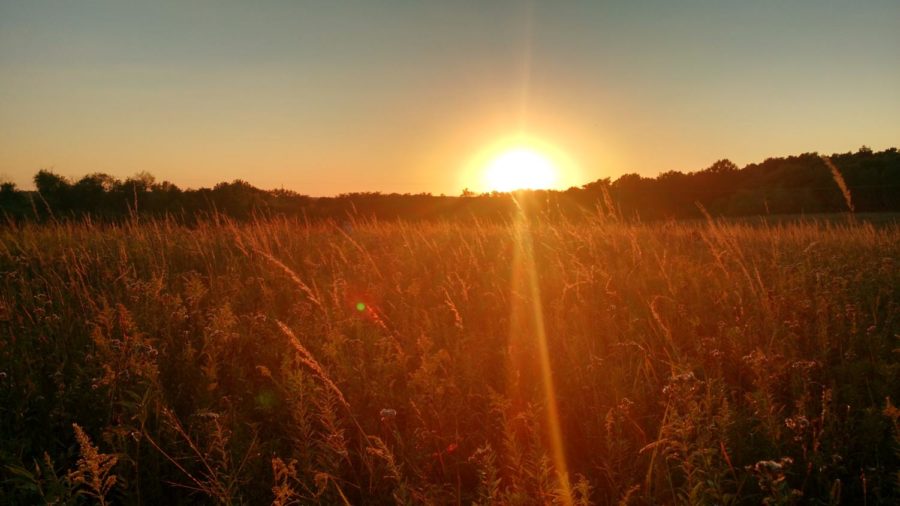Kearney: This summer, we should all spend more time in nature’s beauty
Courtesy of Iowa Natural Heritage Foundation
sunset prairie
May 14, 2018
We’ve finally escaped the grip of a long, persistent winter and found ourselves in the sun’s warm embrace – at least for the few fleeting months of May, June, July and August. Then, with the end of September, we’ll start to see the cold creep back in as we go from tank tops to jackets to heavy winter coats again. Yes, summer only lasts so long; so make the most of it.
You’ll have plenty of time to play Fortnite (or whatever the next trending game is) when the snow and wind force you inside your apartment with your fluorescent lights, electric furnaces and TV screens. But now, while the weather is warm and school is out of session (for most of us), it’s time to reap the innumerable benefits that immersion in nature provides.
As much as we love our easily accessible, air-conditioned indoor activities, taking the time to go forth into nature is a rewarding experience that just can’t be simulated – and the science is clear on this point. Researchers across the globe have been providing backing to what outdoor enthusiasts already know; being in nature is good for your mental and physical health.
For starters, there’s the well-known fact that the body synthesizes vitamin D; some studies have found that a deficit of this essential nutrient contributes to a variety of chronic diseases like osteoporosis, diabetes and cancer, as well as mental disorders such as depression.
This is one explanation given for seasonal affective disorder (SAD), otherwise known as the “winter blues”. Less opportunities to go outside mean less sunlight, less vitamin D and, you guessed it, crappier moods.
The outdoors also improves your health through physical activity. Going for a hike in the woods forces you to use your body in variable ways, whether you’re walking rough terrain, scaling a hillside, carrying a pack or just covering distance. Kayaking, swimming and rugged camping also require you to utilize different muscle and cardio systems in your body, without feeling quite like a superset at the gym. It doesn’t feel like work as much as it feels like play, or a time for reflection.
You could call it “passive” exercise, but is it really passive? When you’re out in nature, it’s hard to be passive; you’re actively engaged in the world around you, a world made up of more than just pixels on your screen.
Rich and vibrant emerald greens, floral pastels, earthy hues; rugged and twisted stumps, branches, vines and cracked dirt fissures, crumbling hillsides, flowing waterways; chirps, trills, calls, scuttling mammals, nesting birds and the whistle of wind through the canopy. The air is richly oxygenated and smells like decaying plant matter and wet earth and the sun glows on everything not covered by dense foliage or wispy clouds. Every action costs a breath – not just a stamina bar at the top of your screen.
It’s something more ancient than us, the unifying landscape that inspired both the first modern humans and the poets of every century. It’s what the pioneers worked with when they settled in the plains; it’s where the Sioux, Meskwaki and Fox peoples made a life for themselves before steel. Forgive me for being romantic, but there’s a part of ourselves that we deny when we avoid the natural world.
Working your body and resting your mind in the outdoors just feels natural because, well, it is. You could say we weren’t made to exist in the outdoors, but only if you want to throw 2.1 billion years of evolution out the window. Truth is, the human brain and physique isn’t really adapted to concrete walls, fluorescent lights, or crowded cities, and our physical and mental health is suffering from it.
Today’s youth have made a shift away from the outdoor activities that constituted most recreation of the past and toward the comforts of air-conditioning and attention-grabbing electronic activities; TV, video games, social media and YouTube have fast become the chief pastimes of children in Generation Z, a trend that began with us ’90s kids and our cherished N64s and Saturday morning cartoons.
On a less fun note, we’ve seen a stark rise in the occurrence of depression and anxiety symptoms in the last 80 years, only plateauing with the advent of anti-psychotic medication. I’m not out to attack these digital-age pastimes, much less blame them outright for society’s mental problems; I grew up on Xbox and television just like any “good ol’ ’90s kid”, but looking back, I truly believe I missed some opportunities to get in touch with nature and reap the benefits of physical play. The days my mother let me wander in the woods were the best days. If you’re looking for me this summer, “cash me ousside.”
Ames may not have any thousand-acre national parks, but there are plenty of ways to get your nature fix on and around campus. We’re only about 12 miles from the popular Ledges State Park; if time is scarce and you can’t make the trip, the Reactor Woods just northwest of campus are another state treasure, full of diverse plant and animal species. There’s also the Pammel Woods north of ISU’s Pammel Cemetery and Lake LaVerne is a great place to unwind, hammock or watch the swans hiss at passerby.
On one of the most beautiful college campuses in the country, there’s no excuse not to get in some natural sights and fresh air. Humans are hard-wired to enjoy the outdoors, as hard as it may be for some of you shut-ins to believe, and to pass up on the opportunities of a hot Midwest summer is just a waste.







